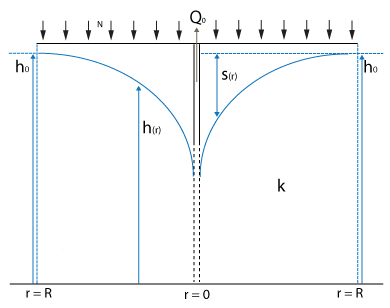Radial well aquifer benchmark (Water Module): Difference between revisions
(→Setup) |
(→Setup) |
||
| Line 28: | Line 28: | ||
An [[Aquifer | An [[Aquifer (Water Overlay)|aquifer]] can be added to configure the [[Aquifer kd (Water Overlay)|kD]] value used in the test. | ||
The simulation is run for 64 days with 0 rainfall, which is configured in the weather's [[Weather rain m (Water Overlay)|rain attribute]] as: <math>[64 \cdot 24 \cdot 3600, 0]</math> | The simulation is run for 64 days with 0 rainfall, which is configured in the weather's [[Weather rain m (Water Overlay)|rain attribute]] as: <math>[64 \cdot 24 \cdot 3600, 0]</math> | ||
Revision as of 15:57, 16 December 2020
This testcase demonstrates a situation where a well is pumping up ground water. A characteristic ground water level curve will form over time.
Formulas
Stationary lowering of the ground water table in a closed water transmissive layer can be described by the following formula [1]
where:
- : stable water level at the considered stable water table edge
- : water level between the considered stable water table edge and the well
- : water level in the well
- : transmissivity of the aquifer in m² / day
- : distance to the well
- : distance of the considered stable water table edge to the well
- : amount of water pumped out in m³ / day
Setup
We use the following setup in our tests. The grid size used is 51 by 51, with a configurable cell size of in meters. There is one underground outlet, which pumps water away continuously with a default amount per second.
The outlet is placed on the cells x = 25 and y = 25 as an inlet with a negative inlet.
INLET Q is set to
UNDERGROUND is set to true (1.0) to place the outlet below the surface.
An aquifer can be added to configure the kD value used in the test.
The simulation is run for 64 days with 0 rainfall, which is configured in the weather's rain attribute as:
References
- ↑ Verruijt, A. (1970). Theory of Groundwater Flow. Macmillan, London.











![{\displaystyle [64\cdot 24\cdot 3600,0]}](https://wikimedia.org/api/rest_v1/media/math/render/svg/df14d65216144e1a7ada4e57939be32f8807b4c2)




